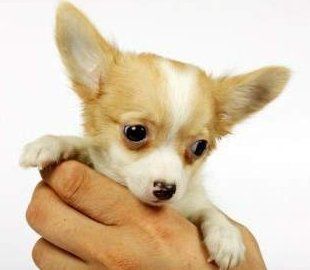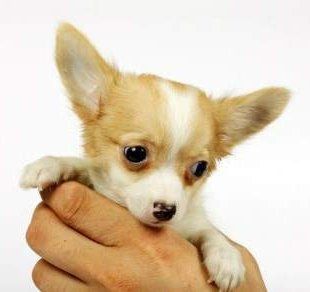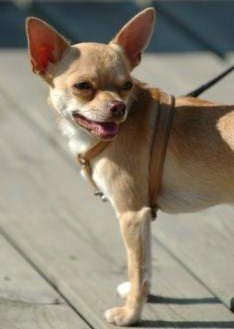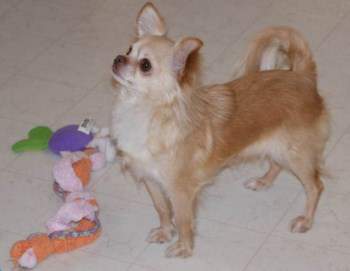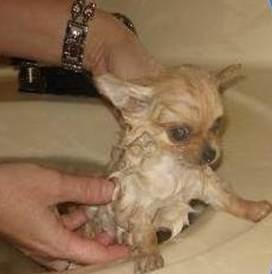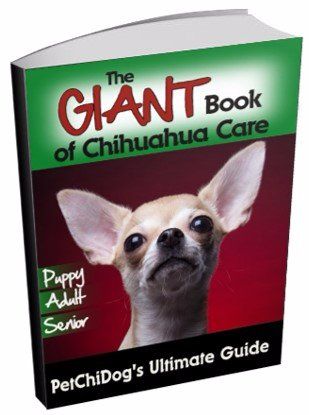Caring for Your Chihuahua
Overview
When an owner wants to understand Chihuahua care, it must first be understood that true care consists of many elements…
They all come together to provide love, health and happiness for the puppy or dog.
With tons of personality but a small frame to contain it, owners need to be a good routine of structure for all aspects of care. This includes, but is not limited to:
- Grooming
- Feeding
- Training - both housebreaking and commands
- Exercise
This breed does well in a variety of environments, including both apartment living and larger homes with lots of land. The Chihuahua does well as a single pet when given enough attention and will also do well in multiple pet households that include both other dogs and even cats.
This breed generally gets along with with children, however there are 2 elements that one must take note of:
1)
Very young children and very young puppies may not be the best mix. This breed can easily be injured by a child that is not able to properly hold, carry and walk a Chihuahua.
2)
During the teething stage, a Chihuahua can become nippy and for this reason a close eye must be kept on any interaction between the puppy and a youngster.
The main care tip to keep in mind is that this breed is not a dog that can simply 'be there'. Owners must be present, engaged and willing to take time for all aspects of care to maintain health and happiness.
Hypoglycemia
One of the most important health issue that can affect a young Chihuahua is Hypoglycemia.
This is the term that is used to describe a rapid, dangerous drop in the blood sugar level of the puppy.
It happens fast, often with little warning. If not treated right away, it can often lead to coma…and then be fatal. Chihuahua puppies from the age of birth to 4 months old are most susceptible to this.
However, one must keep in mind that even an adult dog can develop this, although it is much more rare.
The most common signs are:
- Excessive sleepiness - While Chihuahua puppies do sleep quite a bit, often up to 20 hours per day when very young, one of the signs to look for is weakness and excessive sleepiness.
- Unstable, wobbly walk - Puppies learn to walk at about the age of 3 weeks old, and will begin by being quite wobbly. After the age of 4 weeks, they should be able to stand and walk while holding good balance. Therefore, another sign of hypoglycemia is that when you place the pup down to stand or walk, they are unsteady and wobbly. A Chihuahua may walk into a wall, bump his head into an object, etc.
Treatment:
The treatment for this is 2-fold. You will want to immediately treat this at home by rubbing honey onto the gums of the pup. By doing so, you allow the sugar to be absorbed directly into the bloodstream. AFTER the pup is stabilized, you should then bring him or her to the closest animal hospital or to the veterinarian.This is because in severe cases, the pup will need to have IV treatment. Read more:
Chihuahua Puppy Care
Prevention of Collapsed Trachea
This health condition is as painful as it sounds. It causes both moderate to severe discomfort and breathing problems. This most often occurs with toy dog breeds; the Chihuahua being the most afflicted by this.
The trachea is surrounded by rings of cartilage. When too much pressure is put on this area of the dog, damage can easily occur. If a Chihuahua has a dog collar on that is attached to a leash and the dog lunges (jumps) to the point that the leash is taunt, of the weight and pressure is going to go directly to the windpipe.
This can even happen if you are walking your pup or dog and they suddenly run ahead. If you do not have the chance to catch up, suddenly the leash goes tight and all that weight goes onto the trachea.
When this happens, and it does NOT take a lot of pressure for it to occur, the rings collapse inward. The dog is in a great deal of pain, cannot breathe well and the road to recovery is often a long and expensive one.
Physical Activity
One of the most important aspect of proper Chihuahua care is understanding the limitations of this breed in regard to physical activity.
Here are some great tips to keep your puppy or dog safe and healthy:
1)
While a daily walk is important to allow a pup to release pent up energy and is fantastic for socialization purposes, puppies should not be over-exercised during the 1st year. Too much exertion during this time can interfere with growth plates. A daily walk - once all puppy shots have been given - for 20 to 30 minutes per day (or 2 shorter walks) is advised.
2)
This breed should not be allowed to jump from heights. A good rule of thumb is to not allow your Chihuahua to jump down from any height more than 2 feet (.6 meters). Injury to the hips or knees can occur.
3) Senior Chihuahua dogs should have ramps for reaching sofas or other areas of comfort to prevent injury.
4)
This breed - as with most - does not do well in very hot weather or very cold weather. During hot summer
months, limit outdoor activity to early mornings or later in the evening as the sun prepares to set. Be aware of surfaces such as hot pavements.
Staying in the shade or implementing dog shoes can protect the paws. Since this breed can be sensitive to seasonal allergies, wash off the paws and limbs before entering back into the home if the dog has been on the grass.
Take note of any panting - a sign of over-exertion - seeking rest in the shade along with cool water.
During the winter, a Chihuahua may enjoy playing in the snow, but do limit this time to about 20 minutes. When walking in the wintertime, be aware of ice melt chemicals that are often sprayed by city municipal services along roadways.
These compounds can cause chemical burn to the paws. Boots can be worn for protection or paw wax can be used. Washing the paws with warm water after coming back into the house can help as well.
5)
Never allow your Chihuahua to go off-leash unless in a safe, enclosed yard. This breed is notorious for finding small weaknesses in fencing and escaping in the blink of an eye. Always maintaining an on-leash policy also prevents roadway dangers and close encounters with unknown dogs.
Read more: Chihuahua exercise
The Ears
Routinely check your Chihuahua's ears for any long, stray hairs that may be growing inside of the ear. If these are left, they make for a breeding ground for bacteria (causing infections) and possible ear mites. Any strays should be plucked out. This can be done by hand or with a pair of tweezers. Ear powder will help you gain a better grip if you are having a problem holding onto a particular strand.
The Paws
Unless a puppy or dog is limping, few owners routinely check the underside of their dog’s paws. However, this should be done.Routinely check for any sores, slivers, or cuts. For long coat Chihuahuas, stray hairs can grow out from between the pads on the underside of the paws. When this happens, the dog is walking on the hairs and this can be painful as hairs pull at the skin. It can also cause traction issues. Any hairs that are long enough to grow past the pads should be very carefully trimmed to be level with the pads.
Read more about Chihuahua paw care
which covers guidelines to keep the paws healthy as well as treatment for common issues.
See Also:
Chihuahua Ear Care - Common issues and preventing and treating infection. Keeping the ears clean.
Chihuahua Health Problems - The top issues that this breed is prone to. Signs, diagnosing, treatment options, and when applicable, prevention.
Chihuahua Skin Care - A round-up of common issues seen, and steps for both prevention and treatment.
Anal Glands
One of the most concerning aspects of those who ask how to take care of a Chihuahua dog is the issue of anal glands. This is many times overlooked until they are impacted. Owners who do not know about these can be taken by surprise and not understand what is happening if one or both break open…causing quite a mess and a hard to describe over-powering odor.
The anal glands are very small, peanut shaped glands, one each side of the anal opening. These hold a fluid that is normally secreted in minuscule quantities. It is the scent that allows dogs to identify each other.
It is not uncommon for the fluid to build up and become engorged. It is at this time that they should be “expressed”. It is akin to popping a pimple, however the liquid is usually a dark red / black and the smell is overwhelming. For this reason, many owners choose to have a groomer or veterinarian take care of this aspect.
If they are not expressed, one of two things will happen:
1)
The liquid will eventually turn to a thick pasty substance and then the dog will become extremely uncomfortable and a veterinarian will need to do a procedure to remove the hardened substance.
2)
They will rip open; most often occurring when the dog scoots his bottom along the ground during or after a bowel movement. This leaves the broken skin open to infection. .
Photo courtesy Marquis Royal Chihuahuas
Baths
New owners are often unsure about what age to begin...And for those with older dogs, cleaning too often can cause dry skin issues.
From birth to 7 or 8 weeks, the dam will keep her puppies clean. At 8 weeks old, an owner may begin giving shampooing and conditioning. This breed does best in a kitchen sink where an owner can have a good grasp with minimal water.
In this way, a Chihuahua feels safer and does not feel “lost” in a big bath tub. Water should be lukewarm and filled BEFORE the dog is put in. Testing the water with the inside of your wrist will give you a good idea of how hot or cold it will feel for your dog.
ONLY canine shampoo and conditioner should be used. It is never a good idea to use human shampoo, since the Ph level will be incorrect for your Chihuahua’s skin. Doing so can cause itching, dry skin, etc. Conditioner should be used, especially with long coats.
One important step to this is to make sure ears are THOROUGHLY dry. When moisture is allowed to remain, it creates a perfect breeding ground for bacterial and/or yeast infections. For those that tolerate it, cotton can be placed in the ears during a bath. After bath time, a small, dry and soft washcloth should be used to wipe the inside of the ear flaps.
Dental Care
One of the most overlooked elements of care is cleaning the teeth. This is partly due to the misinformation that owner receive regarding a chew's ability to clear the teeth of plague and tarter. While dental specific treats do play a role in maintaining good oral hygiene, they are not a replacement for at-home
dental care and brushings or professional cleanings.
Brushing and taking good care of a Chihuahua's teeth is just as important during the puppy phase as it is for adults. While milk teeth will fall out during teething, decay deep in the gums will affect the teeth that have yet to emerge.
For Chihuahua of any age, a daily brushing should be done with a proper canine toothbrush and canine paste. Without regular cleanings, decay and rot will not only affect teeth causing them to loosen and eventually fall out, but will also spread under the gum line. Once there, infection can spread to other parts of the body including the heart and lungs.
Training
A vital element to care for this breed,
house training can seem overwhelming at first, however by following easy guidelines, a Chihuahua can be trained in as little as 3 to 4 weeks.
While some will adapt to indoor pee-pad training, most do best with an outdoor designated area where the dog is able to choose just the 'right spot' which canines have an instinct to do.
Maintaining a strict schedule and having all household members be involved will expedite the process. Owners should keep in mind that a puppy will only be able to hold his needs for a few hours. However, as each month passes, this time will increase. Health, adult Chihuahuas are able to hold their needs for 8 to 9 hours.
This breed often needs a refresher course if moved into a new house with a new layout. Seniors will sometimes have setbacks or will need to be taken out more often than there younger counterparts.
Feeding
While all care elements are important and work together to keep a Chihuahua healthy, the most important aspect of them all is feeding. What a dog eats has a direct impact to his health. Food affects possible allergies, energy levels, healthy weight, a strong body, muscle mass, a healthy heart and more.
Here are a few tips regarding food care elements:
1)
Stay away from brightly colored commercial snacks. Orange or red treats have high levels of artificial coloring which is a major trigger for allergies. Stick with white or cream colored treats or wholesome, real foods such as raw baby carrots.
2)
Use stainless steel or ceramic bowls. Dishes that are made with brightly colored plastic leak dye into water and food.
3)
The breed does well with real meats such as chicken, lamb and fish. Beware of commercial brands that show meat by-products as an ingredient.
By-products can legally be roadkill, animals that have died on route to other facilities and chicken beaks.
4)
Vegetables and fruit should be part of a healthy, well-rounded diet. The Chihuahua breed does well with potatoes, peas and carrots. Raspberries, blueberries and banana wedges can also be great additions to meals. Read more:
Best foods for a Chihuahua.
New
- Great Gifts to Give to a Chihuahua
- Don't just buy gifts for the sake of it, get your Chi some things that he could really use. See our awesome gift ideas that in some way help a Chihuahua, depending on his needs.
Other helpful pages:
Chihuahua is stung by bee, wasp, hornet, fire ants
- Know how to avoid this and be prepared to properly react if this should this happen to your little guy or gal.
Chihuahua Dos and Don'ts
- A super-helpful list of the most important dos and don'ts for health and safety. How many of these are you following?
Are Chihuahuas More Suitable for One-Person or Family Households
- While the Chi can do well in both types of homes, see the most common issues with both scenarios and how to resolve them.

